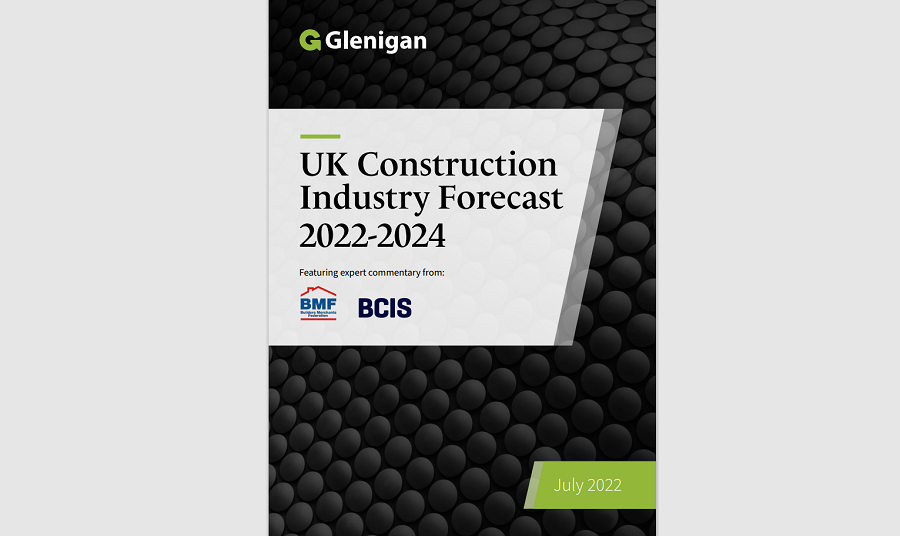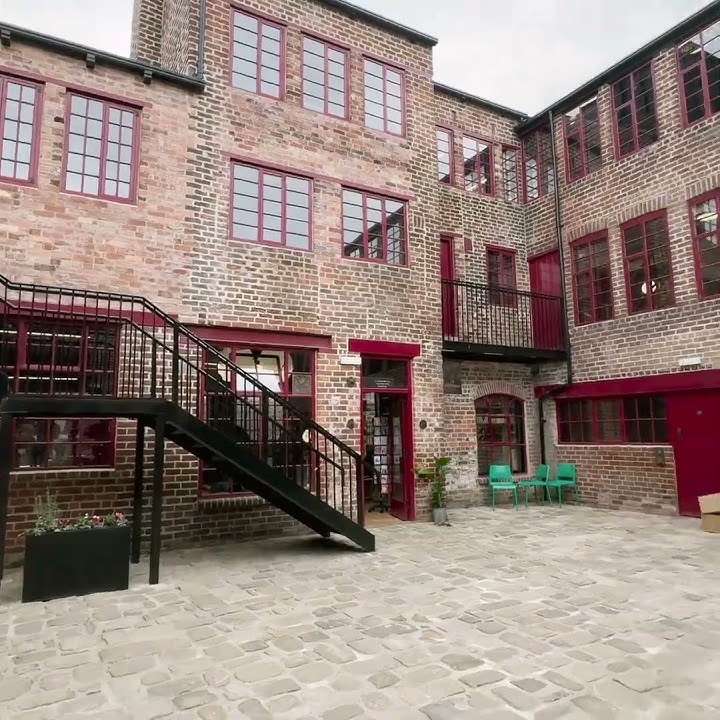Construction growth has faltered after a post-pandemic boost at the start of last year but there will be a return to stronger growth in the short-term, according to the latest industry construction forecast from Glenigan.
A rise in construction project starts produced by the lifting of Covid-19 restrictions slowed at the end of last year.
Economic shocks from Russia’s invasion of Ukraine and China’s Zero Covid strategy also had an impact and Glenigan expects the underlying value of construction starts (projects with a construction value of less than £100 million) to be around £67.8 billion.
This figure is 23% higher than in 2020, when the pandemic took its biggest toll on the construction industry, but a drop of 2% on last year.

Economics director Allan Wilén said: “Firstly, Covid restrictions, and latterly material and labour supply issues, have delayed work on-site, prompting contractors to reschedule their development programmes. Material cost and availability issues may also be prompting contractors and clients to reappraise the design and costing of planned projects.”
This reappraisal has slowed construction projects moving to site, which is behind the fall expected this year. Glenigan analysis has identified a 23% increase in the time typically taken for a project to progress from a detailed planning consent to construction work starting on site. In 2019, this time lag was 16 weeks. This measure has now risen to 21 weeks.
There are positive indications emerging that should drive a recovery in 2023, when starts are expected to increase by 8%, but wider economic concerns remain.
Mr Wilén adds: “Glenigan has seen a stabilisation in project starts in recent months and material availability issues for many products are expected to ease over the remainder of this year. However, the sharp rise in energy costs is set to increase material price inflation and is likely to prompt some clients, especially those with constrained budgets, to reappraise planned projects.”
Key factors
Glenigan expects this growth to continue into 2024 but at a slower rate of 2% as these wider economic factors take their toll.
The current spike in inflation, higher taxes and rising mortgage costs are all expected to limit construction activity in consumer-related areas. Private residential work in particular is expected to be affected.
This is highlighted as one of six key areas set to influence the performance of the industry in the near term, but bright spots are emerging in some other sectors.
Mr Wilén added: “Public sector investment will support education, health and community & amenity starts, while there will also be a rise in office refurbishment work as premises are remodelled to accommodate a shift in post-pandemic working practices.”
Glenigan expects that hotel & leisure construction work will weaken as consumer spending activity moderates, but the increasing shift to online retailing will be a catalyst for increased investment in logistics facilities.
Civil engineering workloads will also be buoyed by a number of major projects.
Public sector pipeline
Growth in education construction project starts is expected to double between this year and 2023 to 14% after the October 2021 Spending Review revealed that the Department of Education’s annual capital budget will strengthen significantly over the next two years.
The government’s programme to rebuild 500 schools in response to a predicted rise in school numbers has been slow to get going. However, between this year and 2023 around 300 school projects will be prioritised (Project ID: 14175517).
A Department of Health programme to build up to 40 new hospitals by 2030 has been slow to materialise and faces an enquiry from the National Audit Office but the value of health projects securing planning permission has risen consistently since 2019. The latest Spending Review also included a £4.2 billion increase in capital spending.
Mr Wilén commented: “Additional government funding promised will boost sector activity towards the end of the forecast period and will help to keep the value of project starts above pre-pandemic levels.”
Civil promise
After a predicted fall this year, 2023 will bring a strong rebound in civil engineering work. Major projects starting such as the £3 billion Sofia Wind Farm expansion (Project ID: 19144506) and parts of the HS2 rail scheme (Project ID: 07309143) will drive this growth.
Underlying contract awards (those with a value of less than £100 million) have been falling according to Glenigan’s industry analysis and progress on the £24 billion second Road Investment Strategy (RIS2) has been slow.
Other major projects such as Wind farm developments such as Dogger Bank B/C (Project ID: 20431719) and Hornsea Project Three/Four (Project ID: 16095470) could provide a boost if work starts in the period of the current forecasts. However, Mr Wilén adds: “We do not expect underlying project starts to reach pre-pandemic levels by the end of the forecast period.”
Commercial shift
The shift to increased working from home and the impact on demand for commercial office space is having a positive impact.
Mr Wilén says: “An increase in conversion and refurbishment schemes has boosted project starts in both 2021 and 2022 as tenants and landlords adapt premises to accommodate changing working practices.”
This has translated into strong growth in office construction work during this year.
Office construction project starts have been strong in London and also major provincial cities such as Manchester, Birmingham and Leeds and planning approvals in these regions look set to support continued improvement.
After a slight weakening next year, 2024 will bring a strong rebound in office work towards the end of the forecast period according to Glenigan’s analysis.
Hotel & leisure project starts will rebound this year but remain hindered by factors including lack of airline capacity, high inflation, and weaker household incomes. Glenigan expects these factors to influence investment by clients and keep the value of starts below pre-pandemic levels up to 2024.
Retail and industrial links
The retail sector had been suffering from the gradual impact of a shift to online spending that accelerated during the pandemic. This buoyed the industrial sector, where investment in logistics schemes and warehouses led to starts leaping by 55% rise in 2021 and 11% this year. Going forward, wider economic conditions will impact both sectors.
Mr Wilén says: “Weakened consumer confidence and spiralling manufacturing costs are projected to hold back industrial project starts towards the end of the forecast period.”
The impact of the cost-of-living crisis will also put pressure on the major supermarket chains but the continuing rise of the budget grocers will produce benefits for construction. Lidl is opening 1,100 UK stores by the end of 2025, while Aldi is pushing ahead with plans to add a further 100 stores by 2023.
On the house
The end of the first lockdown unleashed a mini boom in private residential construction work, aided by a short-term cut in stamp duty. The end of this reduction and wider economic weakness reduced activity and underlying project starts are predicted to go into reverse this year before a resurgence in 2023.
“When conditions become more favourable for housebuilders, the sector is poised to take advantage,” says Mr Wilén. “Private housing detailed planning approvals increased 14% in 2021 and contract awards have consistently strengthened since mid-2020.”
In the social housing sector, the latest Spending Review pledged capital funding of £9 billion for 2022/23 for the Department for Levelling Up, Housing & Communities. This will match 2020 levels and Glenigan expects a strong pipeline of approved projects to support activity over the forecast period.
Cost the factor
A range of wider economic issues are set to influence construction activity over the next two years. Disruption to supply chains caused by the pandemic has led to steep rises in the cost of building materials, while wages are not keeping up with the cost of living.
John Newcomb, chief executive officer of the Builders Merchants Federation, says: “Across the board, managing price volatility and labour are now the biggest issues, with the cost of energy and fuel being major drivers for price volatility.
The Building Cost Information Service predicts a 7% rise in building costs in 2022 easing to a rise of 2% next year but concerns remain.
BCIS executive director Joe Martin says: ““Over the next two years materials supply will still be problematic as supply constraints wash through the system, but we expect material prices to stabilise. The war in Ukraine has exacerbated the rise in oil and gas prices, and while oil prices may start to fall, gas prices are likely to remain high, but this situation remains very volatile.”
Material costs may well diminish, but the cost-of-living crisis is expected to impact on labour rates. The Hays/BCIS Site Wage Cost Index shows all-in site rates were up by 11% in the first quarter of this year on the first three months of last year.
Both the cost of materials and labour will be key factors in determining how Glenigan’s predictions for the performance of the construction industry pan out over the next two years.




















